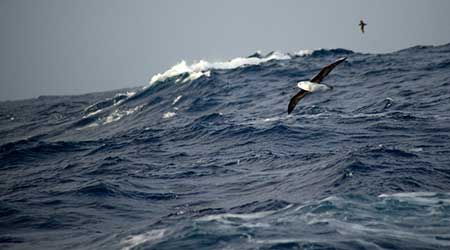Date : 31/05/2023
Relevance: GS-1: Important Geophysical phenomena such as earthquakes, Tsunami, Volcanic activity, cyclone etc., geographical features and their location-changes in critical geographical features (including water-bodies and ice-caps) and in flora and fauna and the effects of such changes.
Key Phrases: Ocean Currents, Antarctica, Overturning Circulation, Overturning Circulation, Marine Life, Antarctic Ice, Oxygen-Depleted Waters, Southern Ocean, Climate Change.
Context:
- Recent research indicates that the deep ocean currents around Antarctica are slowing down at a much faster rate than previously predicted.
Introduction:
- Antarctica plays a significant role in the global network of ocean
currents known as the "overturning circulation."
- This circulation redistributes heat, carbon, and nutrients across the planet, maintaining climate stability and facilitating the transport of oxygen to the deep ocean.
- However, recent research indicates that the deep ocean currents around Antarctica are slowing down at a much faster rate than previously predicted. This slowdown has profound implications for climate, sea levels, and marine life.
- A study published in the journal Nature Climate Change, sheds light on how and why the deep ocean currents in Antarctica have changed over the past three decades.
The Slowing of Overturning Circulation:
- The research reveals that the overturning circulation in Antarctica
has slowed by nearly a third (30%), and oxygen levels in the deep
ocean are declining.
- These changes are occurring earlier than anticipated by climate models.
- The study attributes this slowdown to the melting of Antarctic ice,
which disrupts the formation of Antarctic bottom water.
- The influx of meltwater into the surface waters makes them fresher and less dense, hindering their sinking and subsequently impeding the overturning circulation.
Implications for Climate and Marine Life:
- The consequences of the slowing of bottom water flow and the reduction
of oxygen supply to the deep ocean are far-reaching.
- The depletion of the oxygen-rich bottom water layer leads to its replacement by warmer, oxygen-depleted waters, further decreasing oxygen levels.
- This change can impact various marine organisms that are sensitive to even minor oxygen fluctuations.
- While deep-ocean animals have adapted to low oxygen conditions,
excessive oxygen loss may force them to seek refuge in other regions or
alter their behaviour.
- Models predict a decline of up to 25% in the "viable" environment available to these animals.
- Furthermore, the slowdown of overturning circulation intensifies global warming. The circulation carries carbon dioxide and heat to the deep ocean, effectively storing them and preventing their release into the atmosphere.
- However, as the storage capacity decreases, more carbon dioxide and heat
remain in the atmosphere, exacerbating global warming.
- Additionally, the reduced amount of Antarctic bottom water reaching the ocean floor contributes to rising sea levels due to thermal expansion.
Observations:
- Observing deep ocean currents is a challenging task due to the
remoteness of the Southern Ocean and its harsh conditions.
- Limited access during winter, when bottom water forms, further restricts observations.
- Satellite data also indicates the shrinking of the Antarctic ice sheet, while ocean measurements downstream of regions with rapid melting reveal a decrease in salinity and density of coastal waters.
- To overcome the limitations of sparse observations, the scientists combined different types of data, including ship measurements, moored instruments, and high-resolution numerical simulations.
- By analyzing the data collected from a deep basin south of Australia
that receives bottom water from various sources, they calculated the
strength of the Antarctic bottom water flow and the amount of oxygen it
transports to the deep ocean.
- This region, influenced by significant meltwater inputs, serves as an early indicator of climate-induced changes in the deep ocean.
Findings and Future Projections:
- The research findings are striking. Over a span of three decades, from 1992 to 2017, the overturning circulation in the studied region slowed by 30%, resulting in reduced oxygen supply to the deep ocean.
- This slowdown is primarily caused by the freshening of waters near Antarctica, which decreases the density, volume, and speed of Antarctic bottom water formation.
- Furthermore, the study highlights that the observed slowdown is only
partially offset by a short-lived climate event driven by increased
salinity, indicating the sensitivity of bottom water formation to changes in
salinity on the Antarctic continental shelf.
- It is alarming to note that these changes, initially projected for 2050, are already taking place.
Conclusion:
- The findings of this research underscore the urgency of addressing the issue of greenhouse gas emissions and their impact on the Antarctic ice sheet.
- As global warming continues, ice loss from Antarctica is expected to accelerate, leading to further freshening of surface waters and perpetuating the slowdown of the overturning circulation.
- The consequences of this slowdown extend beyond Antarctica, affecting
the global ocean's climate, sea levels, and marine ecosystems.
- To mitigate these risks and safeguard the stability of our climate and the health of our oceans, it is crucial to prioritize efforts to reduce greenhouse gas emissions.
- Only by taking immediate action can we hope to minimize the detrimental effects of the slowing deep ocean currents in Antarctica and protect our planet for future generations.
Source: The Hindu
Mains Question:
Q. "Discuss the implications of the slowdown in deep ocean currents around Antarctica on global climate stability, sea levels, and marine life. (150 words).







